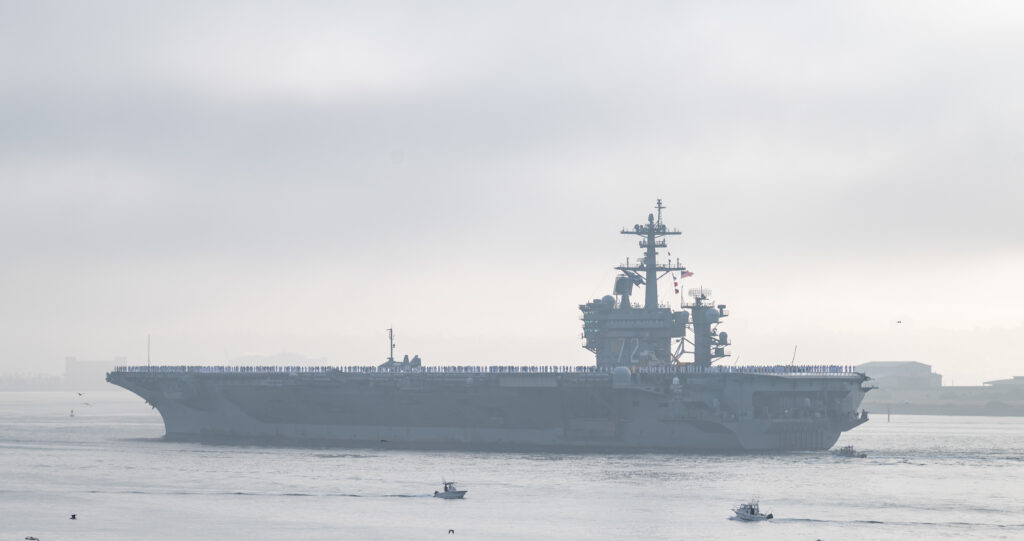
SAN DIEGO — The Abraham Lincoln Carrier Strike Group returned home Aug. 11, marking the end of a seven-month deployment to U.S. 3rd and 7th Fleet area of operations, the USS Abraham Lincoln’s public affairs office said in a release.
The strike group’s flagship, Nimitz-class aircraft carrier USS Abraham Lincoln (CVN 72), arrived at Naval Air Station North Island, while Ticonderoga-class guided missile cruiser USS Mobile Bay (CG 53) and Arleigh Burke-class guided missile destroyer USS Spruance (DDG 111) also arrived at Naval Base San Diego. USS Gridley (DDG 101) and USS Momsen (DDG 102) returned to Naval Station Everett, Washington.
After departing their homeport in San Diego, the strike group conducted dual carrier operations in the South China Sea with the Carl Vinson Carrier Strike Group to demonstrate the U.S. Indo-Pacific Command’s ability to deliver a powerful maritime force with a combined 14,000 Sailors and Marines.
While underway for 220 days, the strike group sailed over 65,000 nautical miles conducting deterrence and presence operations and multinational exercises, including maritime security operations, integrated training between surface and air units, long-range maritime strike, anti-submarine warfare, information warfare operations, maritime interdiction operations, personnel recovery, air defense operations, multiple ship navigation, formation maneuvering and refueling-at-sea operations.
“Abraham Lincoln Sailors have worked exceptionally hard during this dynamic deployment and should be proud of their accomplishments,” said Capt. Amy Bauernschmidt, Abraham Lincoln commanding officer. “It is incredibly humbling to serve alongside these professionals and observe their dedication to the mission. Every day of our seven month deployment, this talented crew displayed grit, resilience and professionalism in the execution of their jobs. Their hard work made the difference as we operated alongside joint and combined forces to ensure a free and open Indo-Pacific.”
The Abraham Lincoln Carrier Strike Group is the first carrier strike group to deploy with a U.S. Marine Corps F-35C Lightning II squadron, Marine Fighter Attack Squadron (VMFA) 314, and the second to deploy with a Navy CMV-22 Osprey squadron, Fleet Logistics Multi-Mission Squadron (VRM) 30. During the deployment, Carrier Air Wing (CVW) 9, embarked aboard Lincoln, executed more than 21,307 fixed-wing and helicopter flight hours comprising of 10,250 sorties, 8,437 launches and 8,487 aircraft arrestments.
The strike group operated alongside other strike groups including the Ronald Reagan Carrier Strike Group, led by Nimitz-class aircraft carrier USS Ronald Reagan (CVN 76), and the Essex Amphibious Ready Group, led by Wasp-class amphibious assault ship USS Essex (LHD 2).
The strike group consists of Abraham Lincoln, embarked staffs of CSG-3, CVW-9 and Destroyer Squadron (DESRON) 21, Mobile Bay, and destroyers USS Fitzgerald (DDG 62), Gridley, Sampson and Spruance. Fitzgerald will return to San Diego at a later date.
The squadrons that make up Carrier Air Wing Nine 9 are fighter attack squadron (VFA) 41, VFA 151 and VFA 14; VMFA 314; VRM 30; electronic attack squadron (VAQ) 133; airborne early warning squadron (VAW) 117; helicopter sea combat squadron (HSC) 14; and helicopter maritime strike squadron (HSM) 71.
- Red Sea Update - April 26, 2024
- U.S. Begins Construction on Temporary Pier to Deliver Humanitarian Aid to Gaza - April 26, 2024
- IKE Carrier Strike Group Arrives in the Eastern Mediterranean - April 26, 2024






